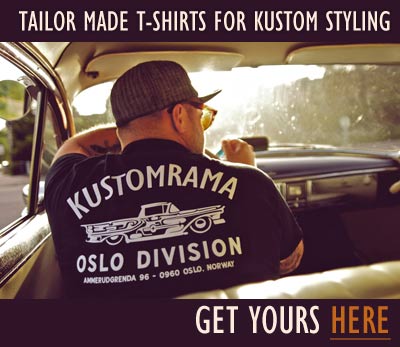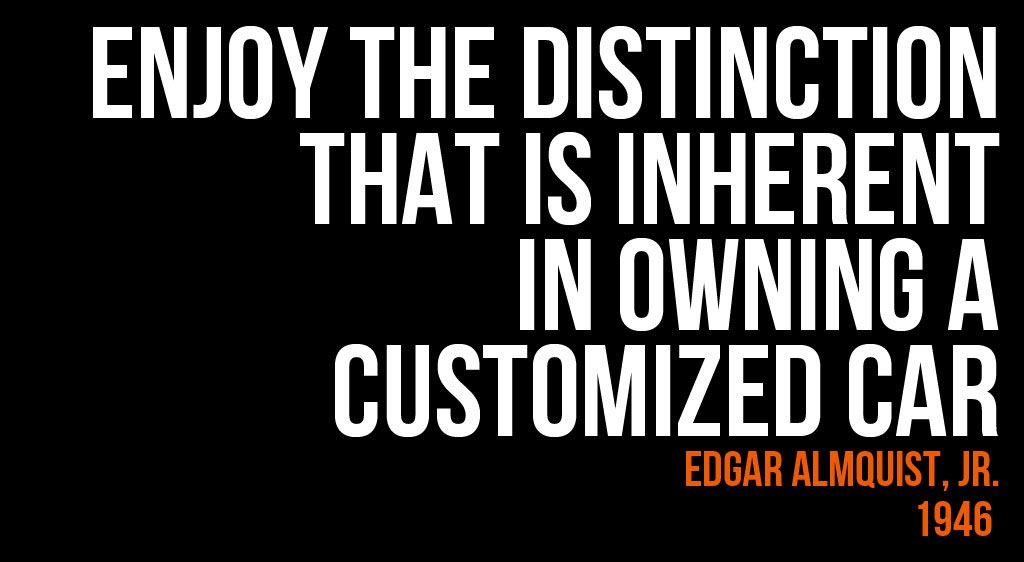Björn Ramsten's 1957 Chevrolet

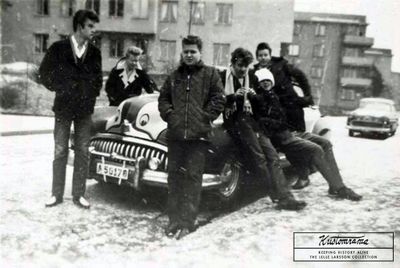
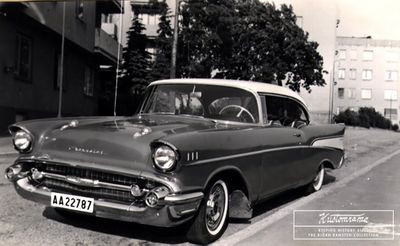
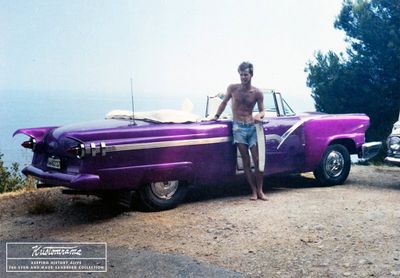
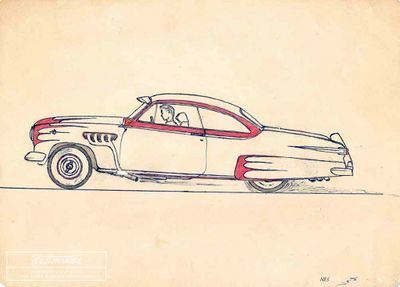
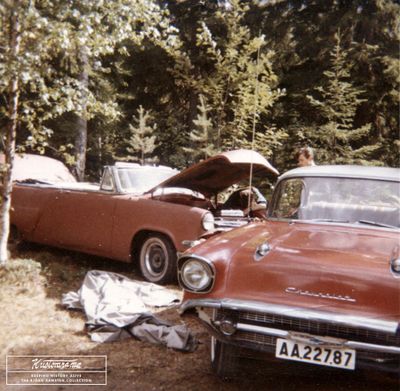
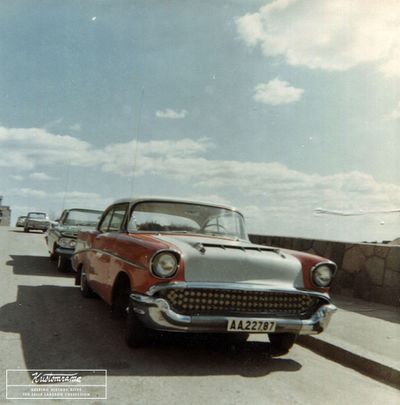
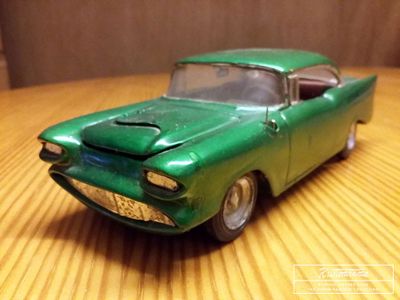

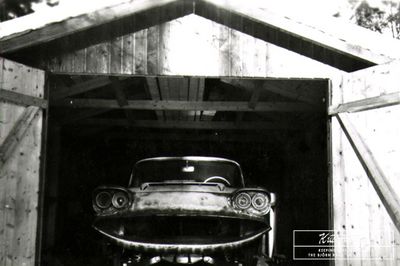
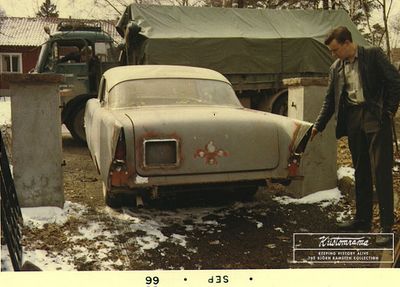
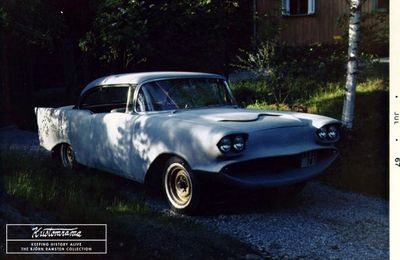
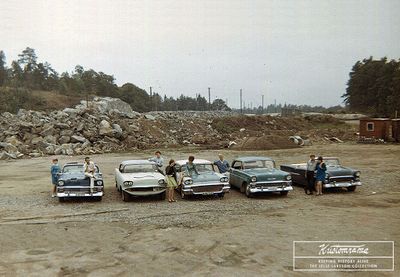
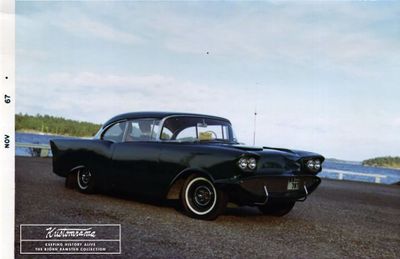
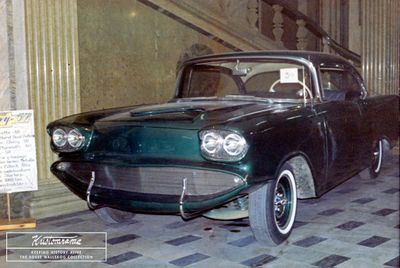
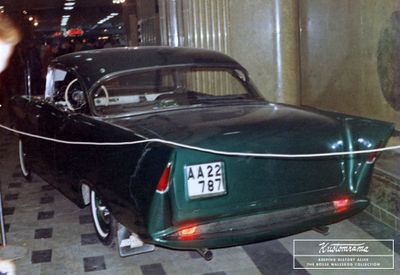
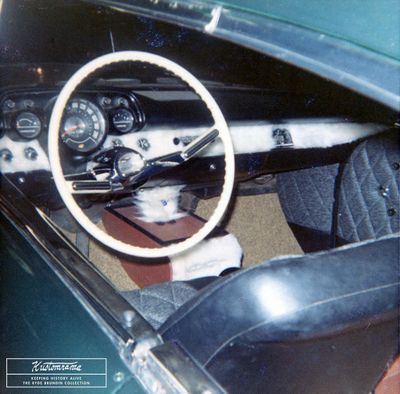
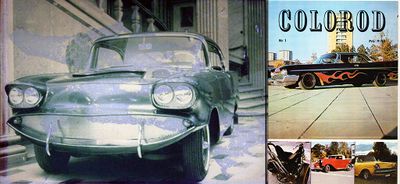
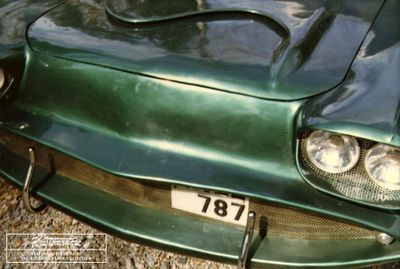
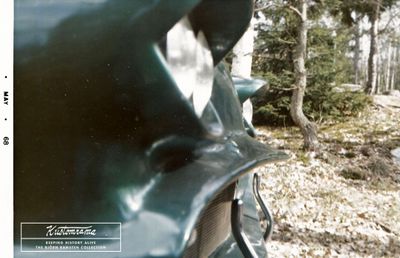

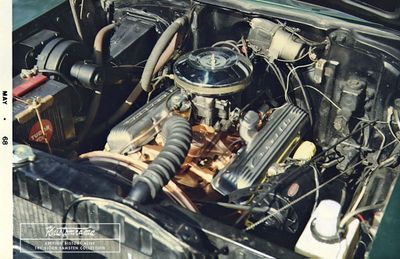

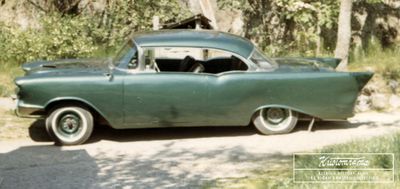
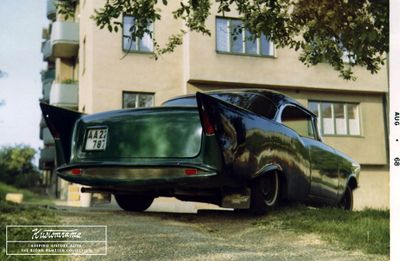



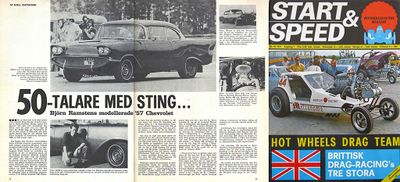




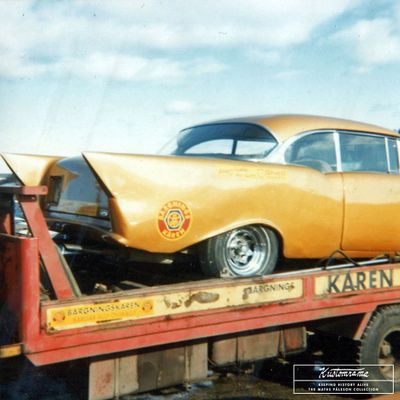
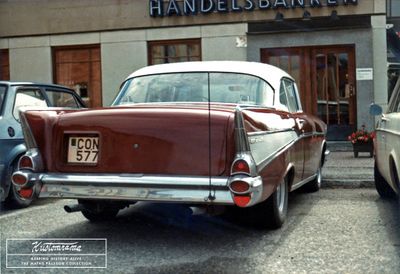
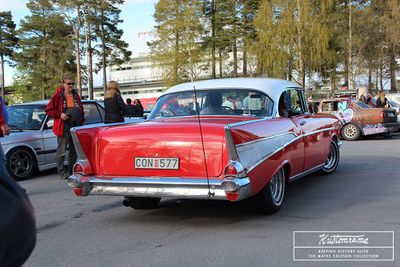
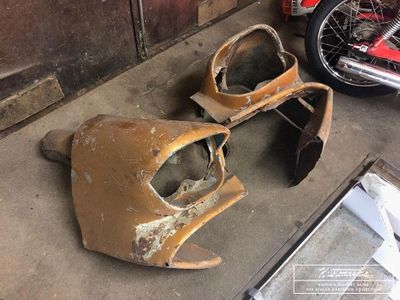
1957 Chevrolet owned and restyled by Björn Ramsten of Stockholm, Sweden. Björn's Chevrolet emerged as a landmark in the evolution of Nordic custom car culture during the 1960s. Combining American styling cues with Swedish innovation, the car became emblematic of an era when passionate young enthusiasts in Stockholm pioneered a movement that celebrated creativity and individuality on wheels.
Contents
- 1 Background and Early Influences
- 2 The Early Customization Phase
- 3 Development of the Custom Build
- 4 Inspired Bill Cushenbery and The Alexander Bros
- 5 Custom Interior and Upholstery
- 6 Performance Enhancements
- 7 Exhibitions, Media Recognition, and Legacy
- 8 Racing Success
- 9 Ownership Changes and Restoration
- 10 Impact on Nordic Custom Culture
- 11 Magazine Features and Appearances
- 12 References
Background and Early Influences
Björn grew up in Fredhäll at Kungsholmen in Stockholm and developed a passion for American cars at an early age. In an interview, Björn told Sondre Kvipt of Kustomrama, "I got my driver’s license when I was 18, and I started driving in 1963. My first car was a Mercury 55." In 1961, Björn established The Flintstones of Hollygroff Car Club with some neighborhood kids. Clubs like The Road Devils, Car Angels, and Teddyboys were prominent in Stockholm back then. "We were 6-7 friends with cars that started a local club called The Flintstones. The Road Devils already ravaged around a bit in folk parks and such, receiving a bit of coverage. We didn’t do that. We were just interested in cars and thought it was fun. It was a guy, Nils-Erik Schullström, who was good at drawing, and he drew a plaque for us." The club name was inspired by the animated sitcom with the same name, and before they were even old enough to drive, the members had pooled together their weekly allowances and bought a 1947 Buick Convertible club car. "A lot of rust repairs, and a little bit of custom work," Björn recalled in 2021, adding that it received a red and white custom paint job that Nils-Erik had sketched on a piece of paper. "Kurre was our driver. He was a couple of years older than us, and he got his driver’s license in 1961. Back then, we used to hang out at Fredhällsfiken Freden, Solstugan, Café Bellman by Karlbergskanalen, Talluddens Cafe at the Solna side of Karlbergskanalen, and Henry’s Cafe in Skarpnäck." The popular Swedish band the HepStars used to play at Cafe Bellman in the early days of their career, Börn recalled.[1]
In 1964, after witnessing custom cars exhibited by Bosse "Gamen" Sandberg and his brother Sven at the Scania building on Ringvägen, Björn became deeply inspired. He recalled to Kustomrama, "After that, I was obsessed with building a custom. Svenne had just completed his Burgundy FoMoCo Ford Sunliner, and that car inspired me a lot."[1]
The Early Customization Phase
Björn’s initial ventures into customization began with minor modifications on club members’ vehicles. Tore Ström's 1954 Ford Sunliner became the first project to receive restyling work. Björn explained to Sondre Kvipt, “Nils-Erik started sketching some customized cars that we thought were cool. After that, we started restyling Tore’s Sunliner. That was the first custom we started working on in 1964.”[1]
Björn sold his stock 1955 Mercury and turned his focus to Chevrolets. His first Chevy, a red and white 1957 two-door hardtop originally powered by an inline-six engine, soon underwent a significant transformation. Reflecting on his influences, Björn told Kustomrama, “After my first car, I stuck to Chevrolets. My first Chevy was a red and white ‘57 two-door hardtop 210 with an inline-six, which I quickly swapped for a 283. It was common back then in Stockholm to race from traffic light to traffic light. We read a lot about tuning and customizing cars in magazines such as Hot Rod, Car Craft, and Rod & Custom.” There was a newsstand at Sveavägen in Stockholm where they sold the American magazines. “There were also certain magazines from the US that I subscribed to,” Björn told Sondre, “those were delivered to our mailbox.”[1]
Development of the Custom Build
By 1965, inspired by American magazine articles and local custom legends, Björn began implementing his ideas on the Chevy. “I started out making a scoop on an extra hood I had. A piece of sheet metal between the torpedoes and some chromed teeth from an Opel Kapitan air-intake.” During his brief period in the army from 1965 to 1966, he experimented further by fabricating a grille from gold-painted sequins. He recalled to Kustomrama, “I handmade all those sequins. Cutting out square pieces of metal that I bent before soldering on a nut and painting them in gold.”[1]
After completing his military service in 1966, Björn dedicated himself fully to converting the car into a full custom. He tested his concepts on a Revell plastic model before scaling them up to metal. Björn’s parents were not into cars. In fact, they didn’t even have a driver’s license. But they supported their son and thought that it was cool that he was passionate about cars, so Björn’s dad helped him build a small garage at their summer place where he could work on the project. The Chevy was Björn’s only means of transportation, and as the garage was a bit out of town, he had to take the bus back and forth while he was working on it. “I got hold of some gas bottles and taught myself how to weld. I started out welding some scrap metal. After a while, it went fairly well, so I shaved the bumpers, all of the emblems, moldings, and door handles of the car.” The Chevy looked nice when Björn bought it, but it had a lot of rust that had to be repaired and replaced before he could complete the rebuild.[1]
Inspired Bill Cushenbery and The Alexander Bros
Björn was a huge fan of Bill Cushenbery, “especially a 58 Chevy that went by the name The Limelighter. I was a huge fan of that one.” The front bumper on the Chevy was therefore scrapped in favor of a rolled pan. A new grille opening, similar to the one Cushenbery made for the Limelighter, was also fabricated from armored tubing before Björn rebuilt the front end with 1958 Chevrolet headlights and an own-designed asymmetrical hood scoop. Björn told Sondre that he believed the inspiration for the asymmetrical styling came from a Ford that the Alexander Brothers in Michigan restyled in the early 1960s. “I didn’t copy theirs, but I made my own version of it.” The front part of the hood was then welded to the fenders before a new hood opening was cut out. Round rod was used to form the outer edge of the asymmetrically themed hood.[1]
Additional modifications included electrical solenoids that opened the shaved doors and deck lid, and a Volvo Amazon hood latch that popped open the pancaked hood. Just as the Limelighter, the grille opening received an inset made from perforated mesh. “Tube grilles had become too common in Sweden by then, so I thought, “Nah, I’m gonna make my own in perforated mesh instead.” Perforated mesh, bought at a hardware store, was cut down and sent off to chrome plating at Qvarnströms at Kungsholmen. Matching chromed perforated mesh was also installed behind the dual headlights. Ordinary accessory blinkers were mounted on the grille for safety purposes before Björn installed two solid nerf bars made from 25mm chromed round iron. “When they did construction work on the roads back then, they had these iron tins that they knocked down into the street to block off traffic. There were no concrete blocks back then. I got hold of a pair of these that I bent in a heavy vice. I did it by hand and had to heat them well to bend them. They were galvanized, so I also had to grind them before I sent them away for chrome plating." Other front-end modifications included dual sunken antennas on the driver-side fender. A key lock placed between the antennas operated the doors.[1]
“It took a lot of sheet metal, tubing, and round rods,” Björn chuckled. “I gas welded everything before I leaded all the seams.” In the back of the car, the rear fenders were extended and modified to house 1960 Plymouth taillights. The gas-filler door was then moved into the trunk before Björn fabricated a rolled pan that housed a rear grille opening. Another treatment inspired by the great Limelighter. Chromed mesh was also installed inside the rear grille opening. The license plate was sunken into the deck lid on the driver’s side of the car. “The license plate was made like a box of milkwhite plastic. It had a light inside and I glued on black letters and numbers.”[1]
Custom Interior and Upholstery
Inside, the front bench seat was replaced with chairs from an older, wrecked Porsche. A center console was made from plywood and covered in walnut, and a 1958 Oldsmobile steering wheel was installed along with an armrest from a 1959 Chevrolet Impala and an 8-track stereo system. The steering wheel was later replaced with a steering wheel from a 1959 Impala. Saddler Allen Brun topped the interior off with a black and white diamond pleated vinyl custom upholstery. Even the inner roof was upholstered in white vinyl with chromed bows from a 1955 Pontiac.[1]
Performance Enhancements
When Björn bought the car, it was powered by a tired 235 cu. In. inline-six engine with a three-speed transmission. “In 1967, I got hold of a 283 with a four-port Carter carburetor, so then I removed that inline-six. I drove that for a while before figuring out that I wanted more power, so I bought a 327 short block from Bosse Kasby at BoMac Racing. Hi-comp pistons and a Z28 camshaft had already been installed when I got it, so it probably came from a Corvette or a Camaro.” Björn remembered that he loaded the short block engine into the trunk of the Chevy and drove it home to the garage. Back home, Musse Pigg heads from a Corvette were installed, along with an Offenhauser high rise intake manifold, a Holley 800 cfm 4-barrel carb, and Hooker headers. The engine received a spray-can copper paint job before Björn squeezed it into the engine compartment. “I started out installing the original 3-speed transmission with a Hurst Mystery floor shifter. A few years later I installed a 4-speed Muncie transmission. The rear end was reinforced with Traction bars and airbags.”[1]
Exhibitions, Media Recognition, and Legacy
“The build was completed in the spring of 1967, and I drove around in grey primer for a while before leaving it at Älta Billack for a paint job sometime during the summer. When it came to the color, I went with Hunter Green Metallic, which was a 1956 Chrysler color. I went looking for colors at a company that sold car paint. I stood there looking for a long time, considering several colors before I fell in love with the Hunter Green Metallic.” Custom accessories included open-wheel spinners from Cal Custom that Björn mounted on the original rims.[1]
Once completed, Björn’s Chevrolet became the most radical custom in the club, and a buddy of his who knew Bosse Gamen told Björn that he had to show the car to Gamen, who was the big Kustom King of Stockholm back then. “That was cool because I drove out to Öreby, where Gamen lived with his parents in a villa. When he came out and saw the car he immediately said “I see you have been inspired by Cushenbery,” Björn chuckled over the phone to Sondre. “Gamen liked my own takes on the design, and I wrote an exhibitor contract for the September Hot Rod Show in Marmorhallarna Stockholm.”[1]
Racing Success
Displaying the Chevy at the Hot Rod Show is one of Björn’s best memories from his time with the car. Another cherished memory is the trip down to Anderstorp for the First Go. “Me and my buddies drove down. It was about 50-60 miles to drive, and it was a great adventure.” Start & Speed magazine was one of the first magazines that began writing about dragracing in Sweden, and in 1968, they came up with the idea of hosting First Go, the first official dragracing event in Sweden. Held at the newly completed Scandinavian Raceway in Anderstorp, there were several race fans eager to finally test their cars on the strip in the Summer of 1968. Customs were common sights at the dragstrips back then, and the cars attending were a mixture of hot rods, customs, dragsters, and standard cars. Since Björn’s car was used both on the street and on the strip, he decided to keep the stock rear end. 4.56 gears were installed when the car was raced, along with 8.00x15 inches M&H slicks. Björn believed he ran against Janne Carlsson's 1961 Ford Thunderbird in his first run. “My wheels spun too much when I took off, but I caught up on the Bird in the end, and we were pretty even over the finish line.”[1]
In 1971, Björn’s Chevrolet gained national recognition when it was featured in Start & Speed magazine. The story was titled “50-talare med sting,” and at the time he had a 14.0-second ET with a top speed of 155 km per hour. Björn became a regular at Mantorp with the custom, and he believed he eventually reached times a little lower than what Start & Speed reported. The Cushenbery-inspired custom was Björn’s only form of transportation, and he continued to use it on the street and on the strip until 1976 when he bought a 1951 Chevrolet convertible. Wanting to spare the convertible from the snow and daily wear and tear, he also bought a 1966 Chevrolet Nova that he used as his daily winter driver.[1]
Ownership Changes and Restoration
After Björn established a family, the vehicle was gradually phased out of regular use. In April 1976, Kent Lundqvist from Bromma purchased the Chevrolet. By the late 1970s, it had received a stock hood and a two-tone red and white paint job. A driving ban imposed on Kent in 1980 led to the car being withdrawn from public use. In July 1981, Åke "Lurven" Stenmark of Bondhagen acquired the vehicle, and by late 1982, ownership passed to Sten-Åke "Stake" Nystedt in Sundsvall. Stake began a restoration aimed at removing many of the custom modifications, a process documented in the Garage Scener-section of Start & Speed Nr.5 1983. The restored car, which retained only the shaved deck lid with its offset license plate, was sold in April 1984 to Esa Juhani Muhonen of Bispgården. Approximately 15 years later, Bert-Ola Johnson of Bräcke became the owner. Recent photographs showed that the car’s only remaining custom feature was the shaved deck lid, revealing its teenage days as a Cushenbery-inspired custom car with a sting on Kungsholmen.[1]
Impact on Nordic Custom Culture
Björn Ramsten's 1957 Chevrolet stands as a milestone in the evolution of Nordic custom cars. Combining American styling cues with Swedish innovation, the build influenced a generation of local hot rodders and customizers. The detailed modifications—from custom grilles and asymmetrical hood scoops to innovative interior designs, were frequently referenced in historical accounts of the era and in publications dedicated to the legacy of Swedish custom car history.
Magazine Features and Appearances
Colorod Nr. 1 1971
Start & Speed Nr 10 1971
Start & Speed Nr.5 1983
References
Did you enjoy this article?
Kustomrama is an encyclopedia dedicated to preserve, share and protect traditional hot rod and custom car history from all over the world.
- Help us keep history alive. For as little as 2.99 USD a month you can become a monthly supporter. Click here to learn more.
- Subscribe to our free newsletter and receive regular updates and stories from Kustomrama.
- Do you know someone who would enjoy this article? Click here to forward it.
Can you help us make this article better?
Please get in touch with us at mail@kustomrama.com if you have additional information or photos to share about Björn Ramsten's 1957 Chevrolet.
This article was made possible by:
SunTec Auto Glass - Auto Glass Services on Vintage and Classic Cars
Finding a replacement windshield, back or side glass can be a difficult task when restoring your vintage or custom classic car. It doesn't have to be though now with auto glass specialist companies like www.suntecautoglass.com. They can source OEM or OEM-equivalent glass for older makes/models; which will ensure a proper fit every time. Check them out for more details!
Do you want to see your company here? Click here for more info about how you can advertise your business on Kustomrama.

